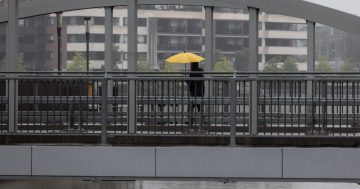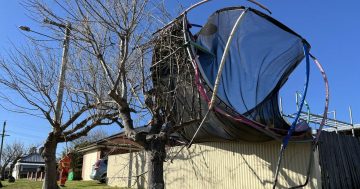
Don’t be afraid to get creative in the search to keep cool this week. Photo: Capital Paddle.
Weather variability is typical in the lead-up to Christmas, but this week is set to be a scorcher for the ACT and southern NSW.
Low-intensity heatwave conditions are spreading across much of inland NSW and the ACT, with the South Coast spared the worst of it – for now.
Bureau of Meteorology spokesperson Kate Doyle said while 32 was the predicted top for Canberra on Tuesday (5 December), the heat would keep building towards the end of the week.
“It’s certainly going to be pretty warm, with above-average temperatures for this time of year,” she said.
It’s because a ridge of high pressure extending across the east, with a trough from the west extending into NSW’s southwest, is drawing heat across much of the region.
Southern coastal districts are being spared the worst of it for now, with a weak southerly change on Wednesday (6 December) to deliver a brief reprieve for those areas. But the heat will build for all regions, with the peak expected on Friday (8 December) as both maximum and minimum temperatures keep things hot.
“Looking at Canberra, the top on Wednesday and Thursday is forecast to be 33 degrees, then 34 for Friday and Saturday,” Ms Doyle said.
“As for minimum temperatures, it will drop to just 15 degrees into Wednesday, 14 degrees into Thursday and then 16 into Friday.
“But Friday night into Saturday is when it will be particularly warm, dropping to just 19 degrees … so there’s not a great chance for you to recover from the top of 34 on Friday.”
Isolated and gusty storms are possible for much of NSW and ACT later in the week, but they’re not expected to deliver significant rainfall at this stage.
It’s this lack of reprieve at night that can create the perfect conditions for heat stress.
Extreme heat can be dangerous for many people, especially older people, babies, children, pregnant and breastfeeding women, people who work outside, people with medical conditions or people who are already unwell.

A low-intensity heatwave warning has already been issued, with the heat set to peak on Friday (8 December). Photo: BoM.
ACT Health advises checking on others during hot periods to make sure people are taking actions to stay cool and protected.
“If you can’t visit them in person, check in by phone. Continue to look out for them after the heatwave as the strain of heat exposure, such as disrupted sleep, can still be felt after the hot weather has passed,” a statement read.
Libraries, shopping centres and community centres can offer cool alternatives to your home if your air-conditioning isn’t sufficient.
The community has also been urged to stay safe if seeking reprieve from the heat by taking a dip in rivers, lakes or pools.
Steps to reduce your risk around waterways include:
- Always let someone know where you are going and when you are planning to return. Ensure they know what to do if you are late in returning.
- Consider your swimming ability before entering the water and know your limits. If you’re unsure, stay out and keep away from the water’s edge.
- Check signage for any warnings and be aware of possible hazards in and around the water. Water depth in rivers can change suddenly, currents can be stronger than they appear, surfaces can be slippery or present trip hazards, and rocks and logs may be hidden below the surface.
- Take a first aid kit and ensure someone in your group is trained to use it.
- Consider your location and whether mobile phone reception or another means of communication is available in the event you need to call for help.
- In an emergency, call triple-zero.
The ACT Government is reviewing all signage and safety information at popular inland swimming spots to make sure hazard messaging is clear and accessible.
A visiting student drowned after an incident at Casuarina Sands last week, while a young man has died after being pulled from a South Coast resort pool.
Safety around pools is also paramount, with home swimming pools one of the most common locations of drowning death of children under five years of age.
Sustainable Building and Construction Minister Rebecca Vassarotti urged people to make sure pool fences, gates and other barriers are secure and shut at all times.
“Consider building your skills and knowledge to help save young lives, such as learning how to perform CPR,” she said.
“For parents and guardians, take some time to help your kids further their swimming skills, teach them how to be safe around water, and closely supervise them while they are in and around the water.”
Original Article published by Claire Fenwicke on Riotact.












